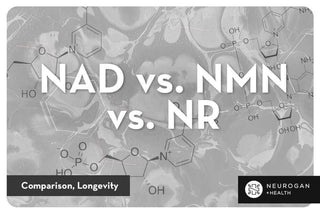NAD is a co-enzyme needed to power your cells. NMN and NR help your body produce NAD.
Nicotinamide adenine dinucleotide (NAD) is a molecule found in every cell in the body — it's needed for energy production and various processes that maintain cellular health. As we get older, NAD levels naturally decline, affecting our energy levels and how quickly our body repairs itself. Supporting healthy NAD levels has become a major focus in longevity research.
Nicotinamide mononucleotide (NMN) and nicotinamide riboside (NR) are precursors to NAD, which means the body uses these compounds to produce NAD — although in different pathways.
NMN vs. NAD vs. NR
The end goal of taking NMN, NAD, or NR supplements is to increase NAD levels in the cells. NMN and NR create NAD through the "salvage pathway."
The salvage pathway is how the body efficiently recycles components of NAD, specifically nicotinamide (NAM) — a byproduct formed when NAD is used in the cells. Instead of letting NAM go to waste, the cells reuse it to create more NAD.
NR is the furthest upstream precursor in this pathway. It converts into NMN before being transformed into NAD+.
Let's look at "The Precursor Tree Line: NR → NMN → NAD+."
-
NMN: NMN is converted to NAD+ in one (and a half) steps:
-
An enzyme called NMNAT adds a phosphate group, turning NMN into NMN-P.
-
Another enzyme, NAD+ synthase, converts NMN-P into NAD+.
-
NR: NR also becomes NAD+ in two steps:
-
It’s first converted to NMN by an enzyme.
-
NMN then follows the same process: it’s phosphorylated and turned into NAD+.

Since NAD levels naturally decline with age, supporting the salvage pathway through NMN or NR supplementation helps the body efficiently regenerate NAD, which we want to support overall cellular health and energy.
This pathway makes NMN and NR such effective precursors for boosting NAD levels compared to taking NAD directly, which is not as easily absorbed by cells.

NMN (Nicotinamide Mononucleotide)
NMN is a direct precursor to NAD+, meaning it has fewer steps to convert into NAD than NR. NMN supplements are produced through industrial-scale biosynthesis by taking nicotinamide (a form of B3) and specific enzymes to transform the compound into NMN.
In 2022, NMN was banned from being sold as a supplement in the U.S. because a company started exploring it as a potential drug. FDA rules say that once something is studied or approved as a drug, it can’t be sold as a supplement anymore.
Right now, NMN is stuck in a legal gray area — not officially a drug or a supplement — making it harder to find. Since the ban, there hasn’t been much progress on approving it as a drug, leaving people unsure about its status.

NR (Nicotinamide Riboside)
NR is another precursor to NAD+ but requires an additional step in the conversion process compared to NMN.
Once inside the body, NR is transformed into NMN, which directly contributes to NAD+ production. NR supplements are typically produced through chemical synthesis, combining nicotinamide (vitamin B3) with ribose.
Unlike NMN, NR remains classified as a dietary supplement, making it more widely available. It's also well-studied for supporting NAD+ levels in the body.

NAD (Nicotinamide Adenine Dinucleotide)
NAD is the end product that NMN and NR convert into — a molecule needed in energy production, DNA repair, and overall cellular health.
While NAD is the end goal for supporting these processes, taking NAD directly as a supplement is less effective because it’s difficult for your body to absorb in its whole form. Most NAD molecules break down before they can be used by your cells, making direct supplementation less efficient.
To address this, we've developed liposomal NAD supplements. These use liposomes, which are tiny fat bubbles, to protect NAD during digestion and improve its absorption. While this method offers promise, it’s still not as widely used as NMN or NR supplementation for boosting NAD+ levels.
For now, precursors like NMN and NR remain the more practical choice if you can’t find easier access to liposomal NAD for raising NAD levels, thanks to their superior bioavailability and established pathways in the body.
|
Compound |
Pros |
Cons |
|
NR |
-Well-researched -Good bioavailability -Many products available |
- Requires additional conversion step to become NAD+ from NR |
|
NMN |
-Highly researched for efficiency in supporting NAD+ -Direct pre-cursor |
- Typically harder to find compared to NR |
|
NAD+ |
-Already in its active form -No conversion needed |
- Poor oral absorption - Some argue that the cells don’t absorb it as well as precursors - Less stable compound (prone to easily degrade. |
Benefits of Boosting NAD Levels
Research suggests that higher NAD levels may support healthy body temperature, weight regulation, and blood pressure [1].
Healthy NAD levels are also associated with improved mitochondrial function in tissues like muscles, the liver, and brown adipose tissue [2]. Supporting NAD levels may also promote cellular health as part of a healthy aging process.
Which Would I Choose? NMN, NR, NAD
Personally, I think NMN stands out as the best choice. It’s the most direct precursor to NAD, requiring fewer steps to convert and efficiently support healthy NAD levels in the body. NMN also has substantial scientific research backing its role in promoting cellular health and energy metabolism [3].
That said, if NMN isn’t accessible due to its current legal status, NR is an excellent alternative. While it requires an extra step to convert into NAD, it’s still effective and widely available, making it a dependable second option.
Resources:
-
Blanco-Vaca, F., Rotllan, N., Canyelles, M., Mauricio, D., Escolà-Gil, J. C., & Julve, J. (2022). NAD+-increasing strategies to improve cardiometabolic health?. Frontiers in Endocrinology, 12, 815565.
-
Xie, N., Zhang, L., Gao, W., Huang, C., Huber, P. E., Zhou, X., ... & Zou, B. (2020). NAD+ metabolism: pathophysiologic mechanisms and therapeutic potential. Signal transduction and targeted therapy, 5(1), 227.
-
Nadeeshani, H., Li, J., Ying, T., Zhang, B., & Lu, J. (2022). Nicotinamide mononucleotide (NMN) as an anti-aging health product–promises and safety concerns. Journal of advanced research, 37, 267-278.




